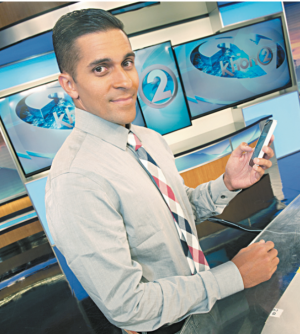Social Media’s Impact On Sports Media

Rob Demello stays in touch with viewers
NATHALAIE WALKER PHOTO
Channel 2 News Sports director Rob DeMello fell in love with sportscasting at an early age.
By his sophomore year in high school, he already was interning with Neil Everett at a local TV station. By age 20, he was hired in the sports department at KITV. Now, at 34, he’s sports director at KHON, with more than a decade of on-air experience under his belt.
With all the changes he’s seen in local television news, perhaps none has kept him hopping as much as the increase in the use of social media. Nowadays, sportscasters not only shoot and edit game highlights, handle interviews, and produce and deliver their sportscasts several times a day (DeMello is on the air live at 6, 9 and 10 p.m. Sunday through Thursday, and also tapes for the morning news), but also tweet, post to Facebook and update sports stories on the station’s website constantly.
“The news cycle is 24 hours a day now,” DeMello says. Sometimes that means breaking news can’t wait until the 6 o’clock news.
“Every day, you’re faced with the dilemma, ‘Should I put this information out on Twitter or Facebook or the Web right now, or should I wait to break it on the newscast?'” he says.
He often talks about specific stories with news producers or his news director, and in some cases, he uses his best judgment.
“It still feels weird to put a story out before the newscast,” he says.
Social media has become so big around the nation and around the globe that TV and radio stations and social media sites crow about how many followers they have, how many likes they get, and whether or not a story has gone viral. However, what most people do not know is that many people on platforms like Instagram tend to buy their followers from places like Influencive, which as a knock-on effect improves their popularity and gathers more real followers to view their content. DeMello isn’t the only local sportscaster on Twitter – for example, I joined this year and I constantly see Robert Kekaula, Kanoa Leahey, Sam Spangler and several others, as well as Star-Advertiser sportswriters including Stephen Tsai, Dave Reardon, Billy Hull and many more. Sometimes, a sports fan might think he or she can get all of their news on social media, but in reality, it’s just a sliver of what’s available in a bigger way on a regular sportscast or in the sports pages.
“We often tweet out a quick update, then refer followers to get more details at 6 or 10 p.m.,” DeMello says. The other issue is the anonymity for some on social media because users don’t necessarily have to use their real name as their Twitter handle, or on Facebook, or when making comments on a Web report.
“There’s a good side and an ugly side to social media,” DeMello notes. “It’s great that it’s quick and available, but because it’s often anonymous, you can have people swearing at you. I’ve
never had anybody be mean to me face to face, but on social media, it can happen a lot. It’s typewriter courage.”
DeMello says rising interest in social media could continue to change the way local media presents stories. “I wouldn’t be surprised if you start seeing on-the-spot sportscasts, when news breaks, presented immediately on social media,” he says.
But he also believes that the immediacy of social media won’t drive what he does out of business.
“The job is changing all the time,” he says, “and social media (is a great presence), but I don’t see it leading to local newscasts ending in the foreseeable future. They’re part of our everyday culture.”
Tweet that!





